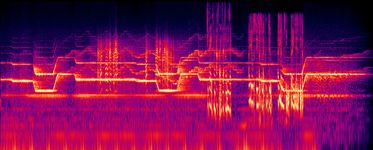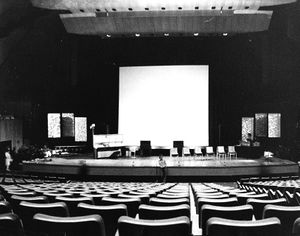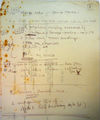I.E.E.100
I.E.E.100 is a seven-minute piece[1] specially composed by Delia for the Radiophonic Workshop in Concert event on the 19th May 1971 at the Royal Festival Hall to celebrate the 100th anniversary of the Institute of Electrical Engineers.
Contents
Quotes
I began by interpreting the actual letters, I.E.E. one hundred, in two different ways. The first one in a morse code version using the morse for I.E.E.100. This I found extremely dull, rhythmically, and so I decided to use the full stops in between the I and the two E's because full stop has a nice sound to it: it goes di-dah di-dah di-dah.[2]
I wanted to have, as well as a rhythmic motive, to have musical motive running throughout the whole piece and so I interpreted the letters again into musical terms. 'I' becomes B, the 'E' remains and 100 I've used in the roman form of C."[2]
Some of it was worked out mathematically. I tried to get into it a feeling of simplicity and loneliness of a man on a moon.[3]
Delia's ability to take on enormous projects to order was [shown] when she composed a special extended electronic piece for the Institute of Electrical Engineers which was performed before the Queen and Prince Philip at the Royal Festival Hall. Taking the initial letters IEE, Delia composed music from their mathematical correspondences and from morse code: introducing elements of the development of electricity in communication from the earliest telephone to the Americans landing on the moon. There was the voice of Mr Gladstone congratulating Mr Edison on inventing the phonograph: the opening and closing down of Savoy Hill with Lord Reith's voice: and Neil Armstrong speaking as he stepped onto the surface of the moon. The powerful punch of Delia's rocket take-off threatened the very fabric of the Festival Hall.[4]
“IEE 100,” [was] intended to show off the capabilities of the new Synthi 100. [...]
In reality, the premiere of Derbyshire's work very nearly didn't happen. Typical of her method of working, she had developed numerous ideas and written detailed notes about the piece, but put off working these ideas out until the last minute. The night before the concert, as Derbyshire was still putting the finishing touches on the piece, concert director Hodgson started to get a bad feeling about her mood. He instructed Workshop engineer Richard Yeoman-Clark to secretly make two copies of the tape she was having him run of the final version of the work and to give Hodgson the second copy that night. He recalls: “I said to Richard, ‘Run another set in Room 12, don't tell Delia you're doing it, and that copy bring to me in the morning, because I have an awful feeling she was going to destroy the tape.’ And he did that. And she came in the next morning in tears, around 11 o'clock. And said, ‘I've destroyed the tape, what are we going to do?’ I don't think she ever forgave me for that.”[5]
In some ways the seven-minute piece resembles much of Derbyshire's earlier works, particularly in the use of complex, drawn-out tape pedal points, in this case, layering on to of these excerpts of famous events in scientific and broadcasting history, such as the Apollo moon landing and the opening and closing of the BBC's Savoy Hill studios.[6]
Papers
DD125111: List of historical events to recall in I.E.E.100
DD125042: Reverse of DD125111: An Outside Studios schedule dated 21 April 1971
DD125131: Notes: "General: Analyse I E E 100 in as many ways as possible: morse code, vowel analyis"
DD125233: Historical events for sections 1 to 6: 1871 morse code, 1877 early telephone, early radio, countdown to liftoff of Apollo 11.
DD125201: Reverse of DD125233: An Outside Studios schedule dated 21 April 1971
DD125258: Notes: "A B C" (reproduced in Special Sound, p.136)
DD125358: List of source recordings to get
DD150238: "Reel 1: 30's Marconi bleeps / 40s "Title music" / Elect. Storm / Telstar tune / Early bird" ... "Walking on moon music"
Tapes
- DD076: Makeup tape
- DD260: "IEE 100 Peter Z"
- TRW 7397: "I.E.E. 100 (Institute of Electrical Engineers Centenary)": "Reel 5 is a stereo recording of the final presentation."[7]
Tracks
This track list is as yet incomplete, as a whole recording of I.E.E.100 is not yet forthcoming but James Perival describes her makeup tape as
archive recordings (Samuel Morse, Lyndon B. Johnson, the opening of Alexandra Palace, the closing of Savoy Hill, Neil Armstrong
so we take those to be the tracks for now.
Samuel Morse
Based on a transcription of the morse code for "I.E.E.C" and harmonic intervals based on those letters. Presumably using the "Samuel Morse" archive material above.
Lyndon B. Johnson
Alexandra Palace
Savoy Hill
"Savoy Hill, in central London opened for medical use in 1889. It became the home of the Institute of Electrical Engineers, which offered accommodation to the British Broadcasting Company in 1923."Cite error: Closing </ref> missing for <ref> tag

Availability
- Performed at the Royal Festival Hall in presence of HRH Queen Elizabeth II on Wednesday 19th May 1971.[7]
- Two short excerpts were broadcast during the Sculptress of Sound documentary on BBC Radio.
 |
|
| Problems listening to this file? See media help. | |
 |
|
| Problems listening to this file? See media help. | |
- Excerpts can be heard in the background of the Wee Have Also Sound Houses radio documentary.
 |
|
| Problems listening to this file? See media help. | |
- The "Man on a Moon" movement is included in the film Sisters with Transistors.[3]
 |
I.E.E.100 (clip from Sisters with Transistors)
|
| Problems listening to this file? See media help. | |
References
- ↑ Special Sound, p.135.
- ↑ 2.0 2.1 Delia, from recordings used in Sculptress of Sound
- ↑ 3.0 3.1 In the film Sisters with Transistors at 36:15.
- ↑ Desmond Briscoe in The BBC Radiophonic Workshop: The First 25 Years
- ↑ Louis Niebur's interviews with Brian from 2004-2008 for Special Sound
- ↑ Louis Niebur, Special Sound, pp. 134-135.
- ↑ 7.0 7.1 The Tape Library List's entry for TRW 7397.








